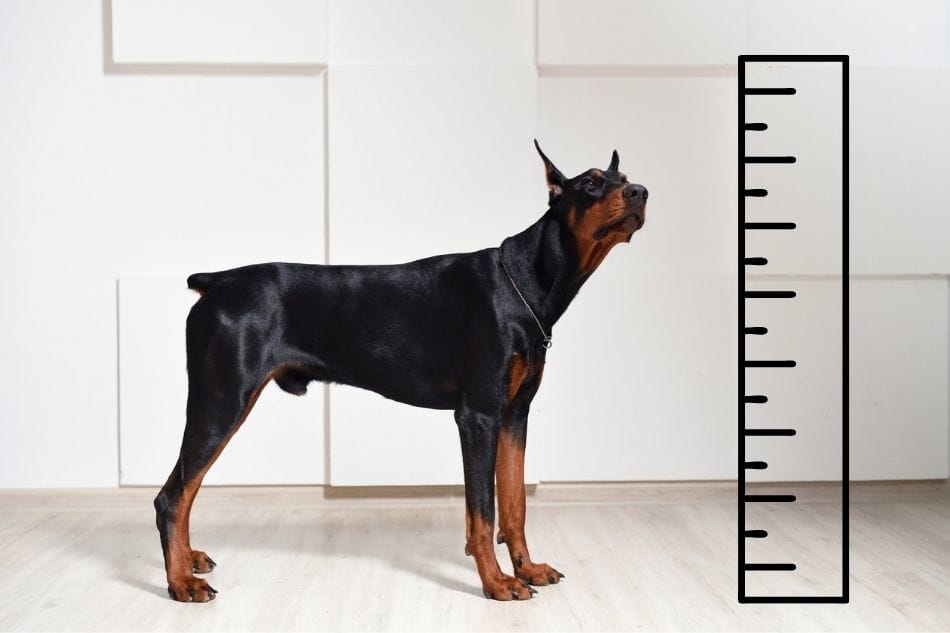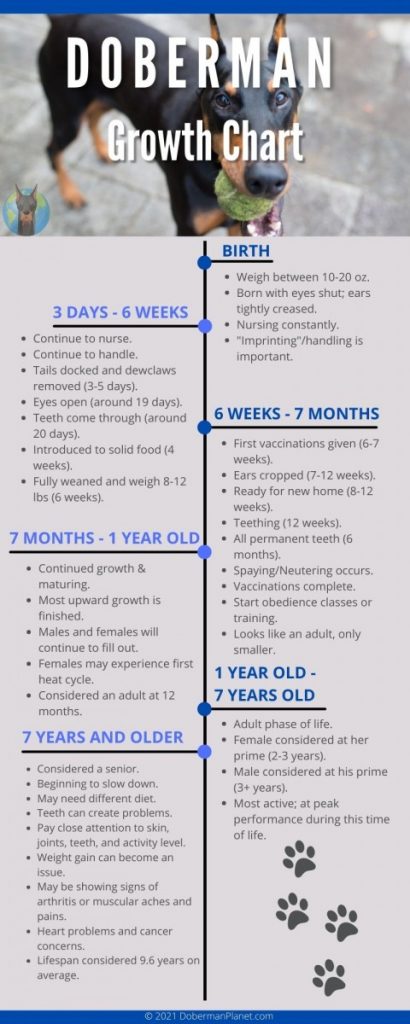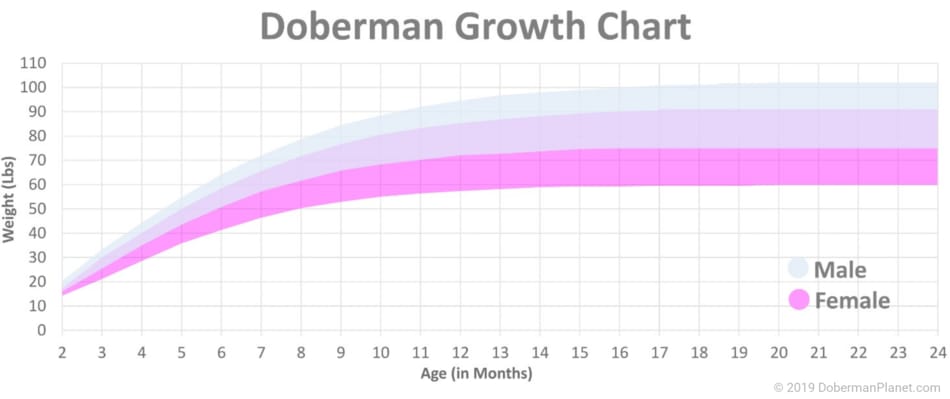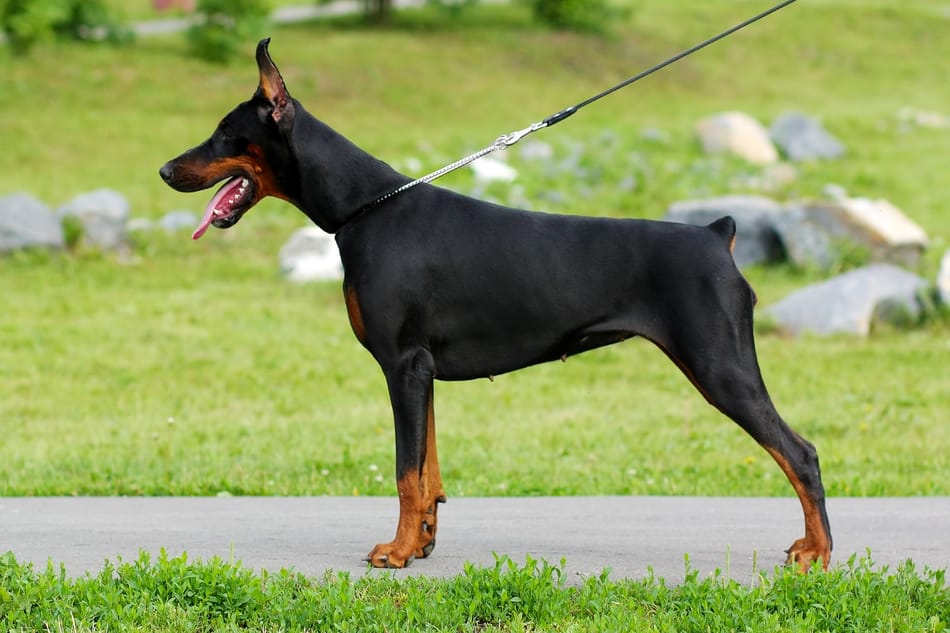
You may be amazed at how fast your Doberman puppy is growing into an adult, especially if this is your first Doberman. It’s very common for owners to want to know when their “monster of a dog” will reach its full size. Understanding when your Doberman will be fully grown will help you gain a better idea of the overall physical status of your dog which can help with everything from training decisions to simple things like which bed or crate to buy.
When is a Doberman full grown? A Doberman is full-grown at two years of age. While Dobermans are considered adults at 12 months old and will have reached their maximum height by that time, they won’t reach their full adult weight until they’re about 24 months old.
These are general statements that seem to hold fairly true for the Doberman breed, but there is certainly a bit more to it than that when we dig a little deeper. The bulk of the clients I work with own Doberman puppies in their first year of life. Their feedback, along with the current research on this breed available, sheds a very interesting light on what to expect from a new puppy in their first year.
The Two Major Growth Phases for a Doberman
As large dogs, Dobermans require more time to grow than many smaller dogs. Reaching expected height and weight is part of the growth process, and a lot of that increase in weight comes with the development of muscle mass.
| Phase | Age | Changes |
|---|---|---|
| 1st Phase | 0 to 12 Months | During this phase, a Doberman will experience most of its growth in terms of height. Their bones and muscles are lengthening quickly as they hit multiple growth spurts. During this time, it’s not uncommon for them to have phases of discomfort or pain (i.e. limping) due to growing pains. |
| 2nd Phase | 12 to 24 Months | After the first year and until about two years of age, a Doberman will usually be done growing in terms of height but will continue to put on weight from the development of additional muscle mass. This is when a Doberman’s frame seems to “fill out”. You’ll notice the development of thicker legs, a broad powerful chest, and a thicker more defined neck during this time. |
It’s worth noting that the second phase of physical development, when a lot of the muscle mass is developed, seems to be most noticeable in the European variety of Doberman. American Dobermans will certainly still develop muscle and “fill out” during this time but it’s less noticeable.
There are many differences between American and European Dobermans, far beyond simply just the development of muscle mass. If you’d like to see more of their differences, take a look at my article all about the differences between American and European Dobermans here.
Doberman Lifetime Growth Stages
Dobies will go through several growth stages throughout their life. Each phase of the Doberman’s life cycle will offer unique challenges and opportunities. The timeline below will give you an idea of what to look for throughout each stage.
Birth
- Weighs between 10-20 oz.
- Born with eyes shut; ears tightly creased.
- Nurse constantly.
- “Imprinting”/handling is important.
3 Days – 6 Weeks
- Continue to nurse.
- Continue to handle.
- Tails docked; dewclaws removed (3-5 days).
- Introduced to solid food (4 weeks).
- Fully weaned; weigh 8-12lbs (6 weeks).
6 Weeks – 7 Months
- First vaccinations given (6-7 weeks)
- Ears cropped (7-12 weeks)
- Ready for new home (8-12 weeks)
- Teething (12 weeks)
- All permanent teeth (6 months)
- Spaying/Neutering
- Vaccinations complete
- Start obedience classes or training
- Looks like an adult, only smaller
7 Months to 1 Year Old
- Continued growth and maturing.
- Most upward growth is finished.
- Males and Females will continue to fill out.
- Females may experience first heat cycle.
- Considered an adult at 12 months.
1 Year Old to 7 Years Old
- Adult phase of life.
- Female considered at her prime (2-3 years).
- Male considered at his prime (3+ years).
- Most active; at peak performance during this time of life .
7 Years and Older
- Considered a senior or a veteran.
- Beginning to slow down .
- May need different diet.
- Willing, but body may be unable.
- Teeth can create problems.
- Pay close attention to skin, joints, teeth, and activity level.
- Weight gain can become an issue.
- May be showing signs of arthritis or muscular aches and pains.
- Heart problems and cancer are major concerns.
- Lifespan considered 9.6 years on average.

TIP: If you’d like more information on exactly how fast a Doberman puppy grows, see my article Doberman Weight: Growth Curve and Average Weights which focuses on how fast you can expect your Doberman to grow.
Puppy-Hood Growth Chart
During their first year of life, a Doberman grows incredibly fast. The general rule of thumb is that a Doberman puppy will gain approximately 10 pounds of weight for every month old that they are.
This rule is fairly accurate up until about 6 months of age. After that point, the growth rate seems to fall slightly behind the 10 pounds per month mark. Below you’ll see a Doberman growth chart to use as a reference showing the different growth rates of male and female Doberman puppies with time.

American Doberman Growth
American and European Dobermans do differ a bit in terms of size and have slightly different physiques. Although it’s pretty easy to see the difference when the two dogs stand side-by-side, many are not aware that such a distinction exists. These differences between the American and European varieties play a significant role in the adult size you can expect.
As most American Dobies have been bred as family pets, they have a somewhat more compact, sleek, and toned look as compared to their European counterparts. They embody the best family pet traits of the breed while being a size that is very suitable for family life. Their appearance could be accurately described as tone and agile, making them perfect outdoor exercise companions.
- An adult male height of 26 to 28 inches and a weight of 75 to 100 pounds is typical of American Doberman lines.
- An adult female height of 24 to 26 inches and weight of 60 to 80 pounds is typical of American Doberman lines.
Some American dogs may exceed these sizes, but it is not as common as it is for dogs from European lines. These weights and heights are also what’s indicated in the American Kennel Club (AKC) breed standard for the Doberman (available here). It’s a good broad range that does seem to reflect accurately to real life with these dogs.
It’s also worth noting that the American Dobermans also seem to reach their adult weight a bit sooner than the European variety.
“A European Doberman will grow to be about 5 to 10 lbs heavier and 1 inch taller than an American Doberman.”
– John Walter (DobermanPlanet.com)
European Doberman Growth
European Dobermans have a size and build that is very consistent with the breed’s history as a guard dog. These dogs have a very muscular build that indicates their natural strength and of course, means additional weight.
The European Doberman is bread to a standard that keeps the dog true to its original purpose as a working dog. That’s why European Dobermans often look thicker, larger, and broader in their overall frame.
- An adult male height of 27 to 28 inches and a weight of 80 to 105 pounds is typical of European Doberman lines.
- An adult female height of 25 to 27 inches and weight of 65 to 85 pounds is typical of European Doberman lines.
Although it’s worth noting that the breed standard for the European Doberman (available here) indicates a different “standard” height and weight for the European Doberman. The European Doberman breed standard states that males should be between 88 to 99 pounds and females between 71 and 77 pounds. In terms of height, it states that males should be between 27 and 28 inches and females between 25 and 27 inches.
The breed standard for the European Dobermans doesn’t indicate a stark difference in size to the Amerian Doberman breed standard, but in the real world, they are certainly larger dogs. The difference is simply that the American breed standard seems to allow for a broader range of heights and weights in their dogs while the European standard is more precise.
These dogs generally take longer than American Dobermans to achieve their adult levels of muscle mass. Physical strength is very evident in the appearance of these dogs.
Male Doberman Growth
Males stop growing in height at about the same time females do, or at around 1 year of age. However, from about 1 to 2 years of age, the males will put on more muscle mass than females will. It’ll also generally take them longer to stop growing than the females.
This additional muscle mass is likely what accounts for some of the weight differences between these two sexes. Males likely grow larger and stronger than their female counterparts due to the additional testosterone hormones. This is one reason neutering a male Doberman early on affects their rate of growth.
Female Doberman Growth
Females will stop growing in terms of their height at about the same time as males do, or at about 1 year of age. From 1 to 2 years of age, females will put on additional weight in terms of muscle but it won’t be as much as male Doberman will.
Female Dobermans have less muscle mass and are smoother, and more elegant, in appearance as compared to their male counterparts. You can read more about their differences in my article all about the differences between male and female Dobermans here. That article will give you a breakdown of the physical, mental, and behavioral differences between the sexes.

Behavioral and Physical Maturity
Starting when your puppy is about 12 to 16 weeks of age, they’ll likely start to go through what I call the “juvenile delinquent” stage where unruly behavior becomes normal as the dog tests his or her limits. This can progress up to as late as 1 year of age.
Unfortunately, the juvenile delinquent stage is not just a phase of testing the limits, it’s also a phase of explosive growth for your Doberman. That means the dog is quickly gaining size and weight.
Owners often decide to have their dogs spayed or neutered at this age to combat some of the more difficult behavior. A Doberman this age is big enough to be challenging to handle without proper training, making a good Doberman-specific training strategy all the more critical.
Even though there is a small variation between males and females in size, Dobermans have a fairly uniform size and build. The breed is naturally energetic, but working on training while they’re still growing will make them far easier to manage. These dogs will enter their prime years for physical activity shortly after reaching their full size.
Behavior Changes
A Doberman’s behavior will change a lot with age. As young puppies under six or seven weeks old, Dobies will still have a lot of dependence on their mothers. This article from Prima Dobermans can give you a good idea of what your Doberman experiences while still in the breeder’s care. But after about 8 weeks of age, most Doberman pups will be ready to leave their mother and go home with their new owners.
Some of the most obvious changes in behavior and temperament that you are most likely to notices are listed below:
- 12-Weeks of Age – Around the time a Doberman puppy is twelve weeks old, he or she will start teething. This is a time when a lot of supervision is necessary for your puppy’s safety and your sanity. Puppies also like to get to know their environment, relieve stress, and soothe their sore gums by chewing. This can be the start of the dreaded puppy nipping or biting stages.
- 6-Months of Age – Your puppy should be nearing the end of their teething and puppy nipping or biting stages. This is also a good age to get a bit more serious about obedience training as aren’t as easily distracted as when they were puppies, but they still will have trouble controlling all their energy which can make some training difficult. Young Dobermans at this age have reached three-quarters of their adult size. Understanding “the house rules” before they’ve reached adult size and strength is crucial for a well-adjusted dog.
- 1-Year of Age – A Doberman between a year and a year and a half old has hopefully left puppyhood behind. Their ability to focus on training should be even higher now and you can begin doing more difficult training like bite work, agility training, or training for other AKC events. They’ll still have plenty of energy, but should have be better at controlling it and have a deeper bond with their owners that will make trianing easier.
- 2-Years of Age – This is when your Doberman will not only be fully grown in terms of height and weight, but should also have reached that more “stoic” phase that the Doberman breed is most known for. Their trainability, physical abilities, and desire to please should be at, or close to, a perfect balance. This is when your Doberman really grows into their own.
This should give you a general idea of the progression of the Doberman as they grow and mature. Keep in mind that females will generally hit these stages a touch sooner as compared to male Dobermans. Additional information regarding all the various growth and development stages a puppy goes through from birth onward can be found in this DPCA article.
IMPORTANT
The “Critical Socialization Window” for dogs is between 4 and 16 weeks of age. During this time, fear is overridden by curiosity. This means it’s incredibly important to expose your Doberman to as many new experiences as possible during this window (source).
Final Thoughts
Although Dobermans might vary somewhat in their expected adult size, owners can usually predict when they will have a fully-grown dog. At one year of age, you can consider a Doberman to be at about their maximum height. At 2 years of age, you can consider a Doberman to be at about their maximum weight. This rule is fairly accurate across the sexes and various types of Doberman.
Creating a consistent training and excercise routine will help make sure that your dog, although large, is a calm, relaxed, and obedient family-friendly dog.
Related Questions
How big is a 6-month-old Doberman? Most Dobermans will weigh 50 to 60 pounds at six months of age, with some variation depending on whether it’s an American or European. Dobermans of this age will have reached 3/4 of their expected adult height and strongly resemble adults.
When do Dobermans calm down? Doberman puppies tend to noticeably calm down at about 1 year of age with proper exercise and mental stimulation. They’ll reach full behavioral maturity at about 2 years of age when they become noticeably more stoic in their demeanor.
At what age do Dobermans reach their full height? Dobermans reach their full adult height at around a year old, with continued growth in overall muscle mass until their second year. Some larger Dobermans from European lines might continue growing in height until they’re closer to two years of age, with increasing muscle growth.


